Hello everybody! In the first part of this blog I wanted to show some photos of insects I took but because I can't upload more than 10 photos I had to split it up. I don't rule out I might even add a third part because I want to share other pics of the rose chafer I saw last weeks and this will give me continuity with the last photos of the previous blog.
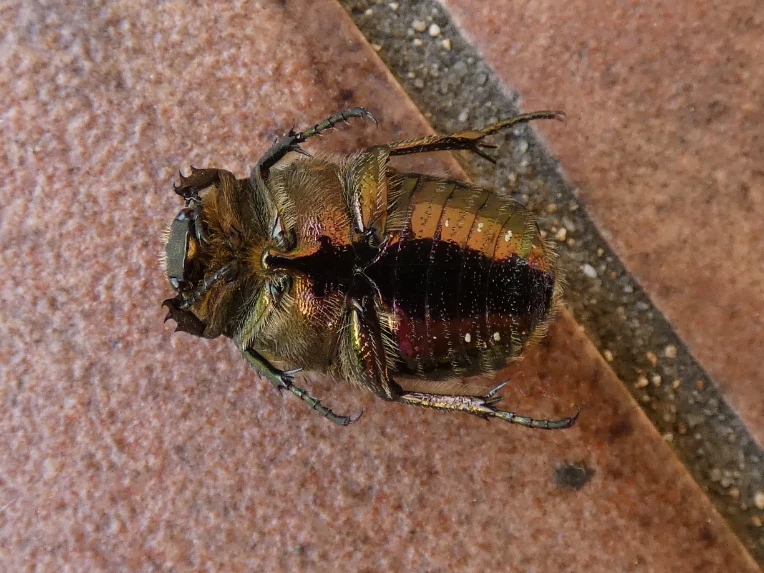
In this photo I wanted to position the insect upside down to photograph segments and sections of the ventral view, then I immediately re-positioned her and put in my vegetable garden like in this pic:
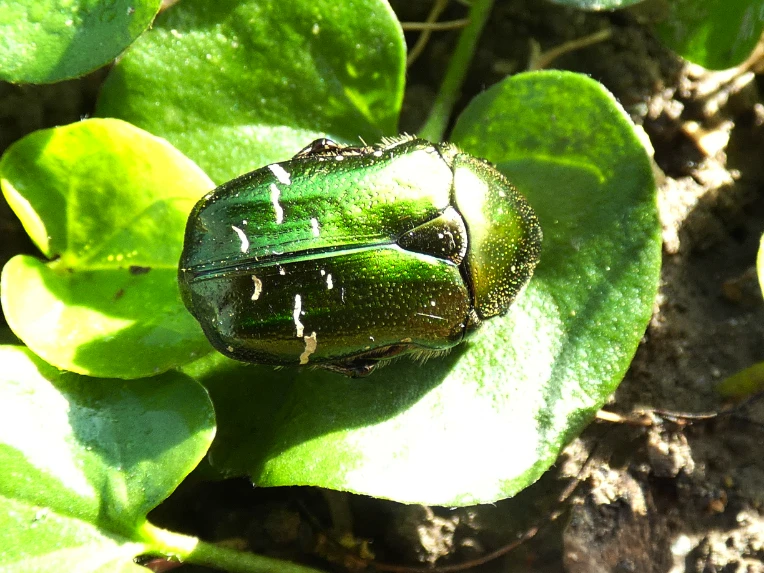
I put her under the sunlight because she was little responsive of stimuli and because it's an ectotherm animal, a nice warm source from the sun is a nice solution.
Harmonia axyridis
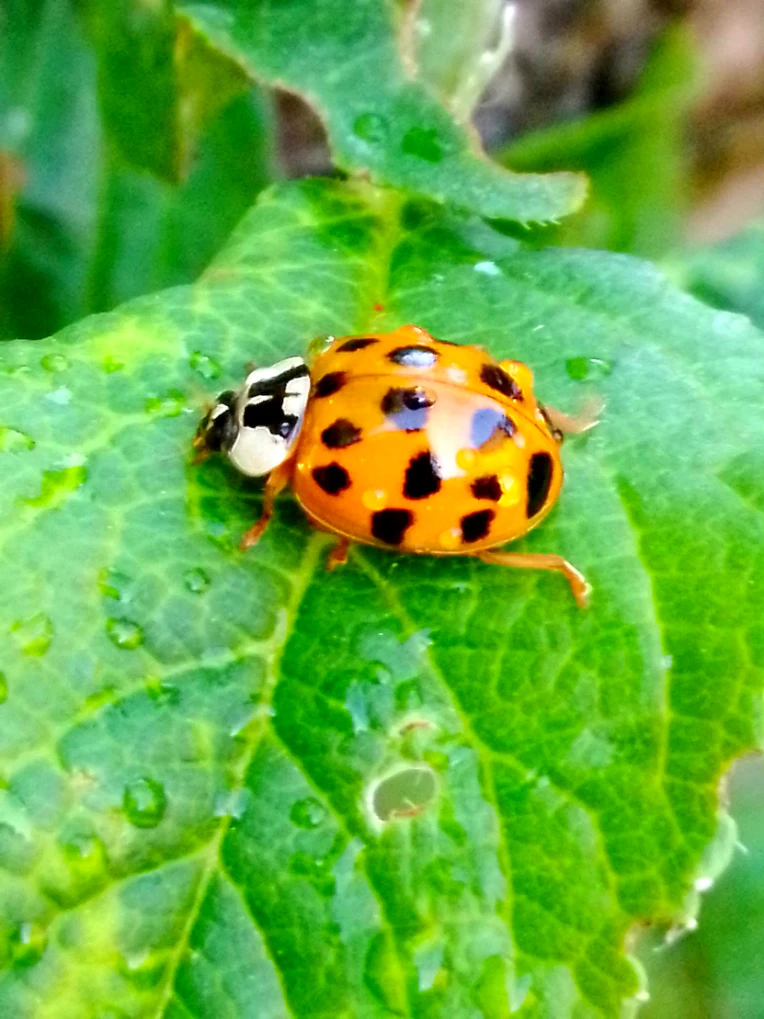
This is the photo of a multicoloured Asian lady beetle (Harmonia axyridis) I took two years ago in my vegetable garden. H. axyridis occurs in many color forms. Adults are strongly oval and convex, about 6 mm long, and 5 mm wide. The common color form, f. "succinea", is orange or red in colouration with 0–22 black spots of variable size. The other usual forms, f. "conspicua" and f. "spectabilis", are uniformly black with, respectively, two or four red markings. The pronotum is white with variable black patterning, ranging from a few black spots in an M formation to almost entirely black. The underside is dark with a wide reddish-brown border. This specimen belongs to the form "succinea". Extreme forms may be entirely black, or feature complex patterns of black, orange and red.
This species is native to eastern Asia from central Siberia, Kazakhstan, and Uzbekistan in the west, through Russia south to the Himalayas and east to the Pacific coast and Japan, including Korea, Mongolia, China, and Taiwan. Because of its ravenous appetite it has been used as biological pest control from farmers, I use them too when I have to deal with aphids on my eggplants and sweet pepper plants but I discovered that home-made garlic spray is even more effective against them.
The human-mediated process of introducing them for biocontrol purposes led this species to spread across Americas, Europe, Israel, New Zealand, and South Africa. This species is widely considered to be one of the world's most invasive insects, partly due to their tendency to overwinter indoors and the unpleasant odor and stain left by their bodily fluids when frightened or crushed, as well as their tendency to bite people. In Europe it is currently increasing to the detriment of indigenous species, its voracious appetite enabling it to outcompete and even consume other ladybirds. The harlequin ladybird is also highly resistant to diseases that affect other ladybird species, and carries a microsporidian parasite to which it is immune, but that can infect and kill other species.
Despite its effectiveness at controlling aphid populations the harlequin has been reported to be a minor agricultural pest that is inadvertently harvested with crops in Iowa, Ohio, New York State, and Ontario. This can cause visible and sensory contamination. Contamination of grapes by this beetle has been found to alter the taste of wine.
I leave you here an interesting study about antibacterial activity of compounds secreted by this insect:
https://pmc.ncbi.nlm.nih.gov/articles/PMC3297383/pdf/rsbl20110760.pdf
Iphiclides podalirius
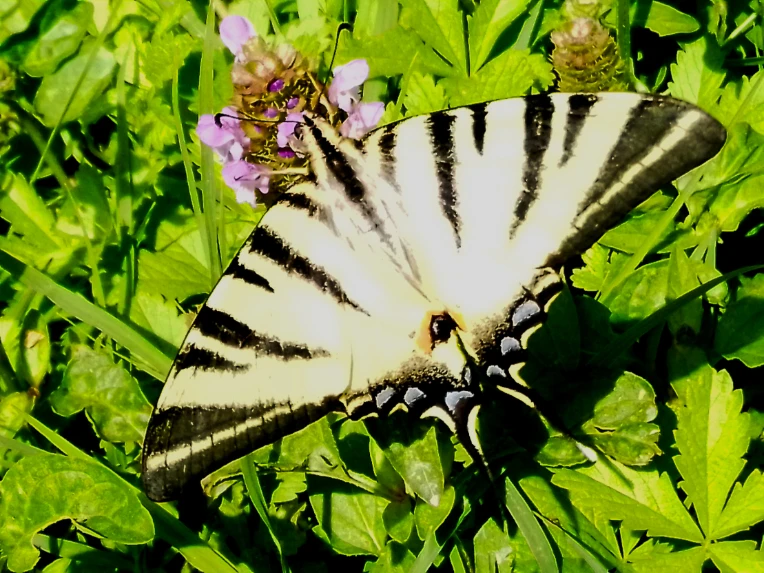
This is a beautiful scarce swallowtail (Iphiclides podalirius) I photographed some spring ago. The distinctive feature of this butterfly is the presence of several long and black tiger stripes in knife-like patterns on a creamy white base. The borders of the hind wings are lined with several inverted crescent moon-like blue markings including the long tail-like protrusion at the end of the two wings. There are also two orange-yellow spots almost in the middle of the secondary wings. Average wingspan for the male is about 60–80 mm while the female has a wingspan of circa 62–90 mm. This species is widely spread across Europe except the northern part, Turkey, Near East, extending to the Middle East across Kazakhstan to the Altai, Southwest Siberia and western part of China.
You can find this little flying gem in scrublands, hedgerows, open orchards, isolated bushes, as well as in human-made gardens, towns and the countryside. Lifespan of adults is 2-3 weeks. First time I had occasion to see this beauty, before her I saw a common yellow swallowtail (Papilio machaon) soaring in the fields during my walks.
Fun fact: the scarce swallowtail butterfly can soar in high altitudes even at alpine levels as high as 2000 m.
TW: SPIDERS (now there will be some pics of spiders, if you have arachnophobia do not continue scrolling this gallery)
Steatoda grossa
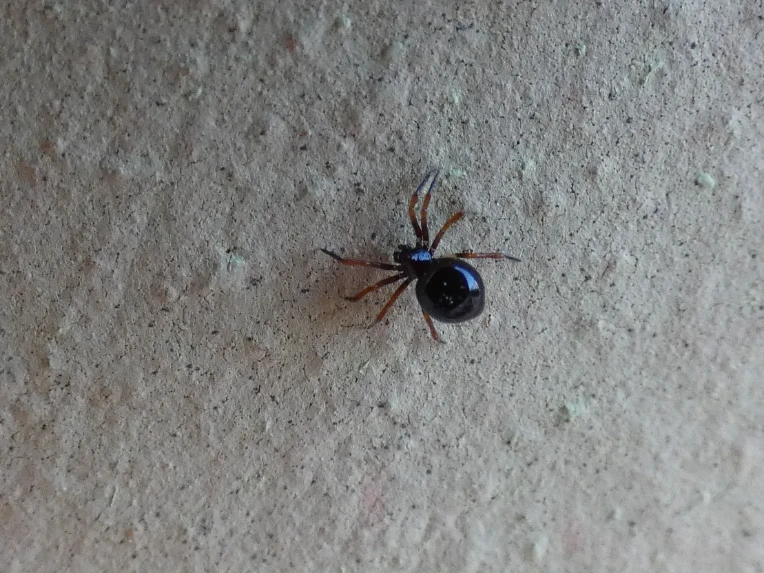
Also known as the cupboard spider or the false widow is a common species of spider found in North America, Australasia, and Europe. This female is about 6-10.5 mm in length and has a black coloration with a round, bulbous abdomen. Typical coloration ranges from purplish brown to black, with light-colored markings but this specimen was all solid black with brown to reddish legs. It is often confused with other venomous spiders in the genus Latrodectus but unlike Latrodectus genus this species does not have a bright red hourglass pattern or any other bright, distinctive markings.
Males are smaller but can many times be nearly as long as the females, and can measures 4.1-10.0 mm in length. It is thinner than the female. I never saw a male, only females. it reportedly preys on black widows. They can go several months without feeding, provided they have access to water. A well-fed female can lay three or more egg sacs each year. Each egg sac typically contains between 40-100 eggs. A really lovely fact about this spider is that the female watches her eggs for hours, even days, at a time once the eggs start changing color and grow close to hatching. An egg will usually hatch within a month of being laid. While the male can live 1-1.5 years, the female can live up to six years.
The bite of this spider is known to be medically significant in humans, but minor, without any long-lasting effects compared to Latrodectus genus. Symptoms of bites include: blistering at the site of the bite, muscle spasms, pain, fever, sweating, and/or a general malaise lasting for several days.
Steatoda triangulosa
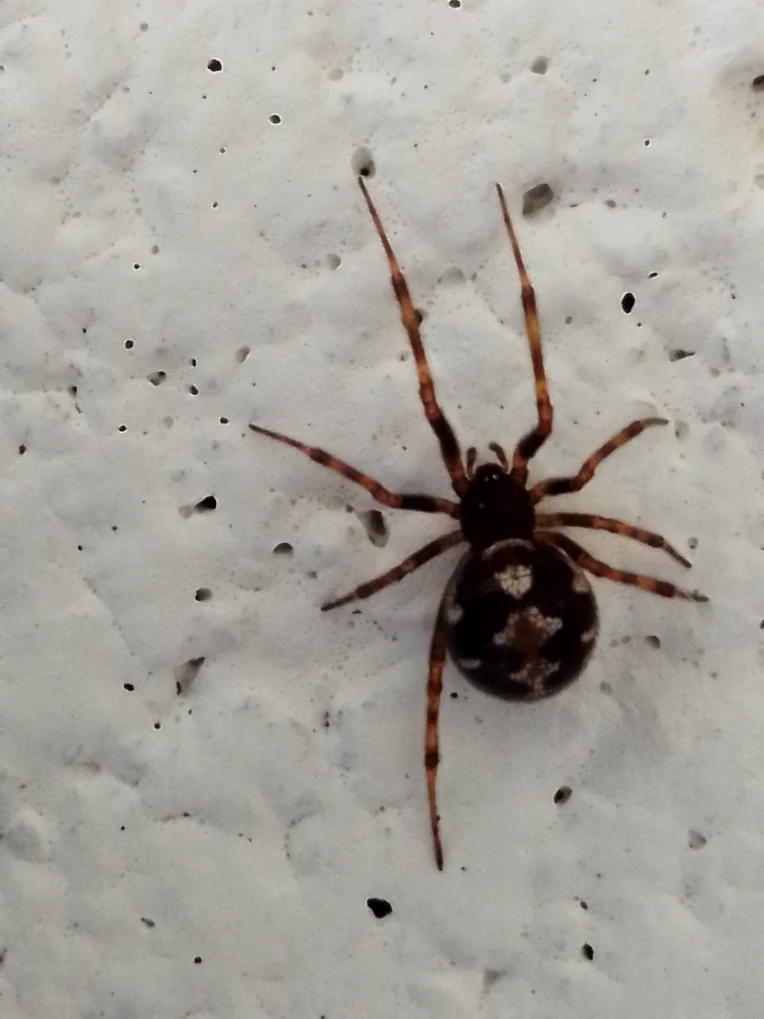
A photo of triangulate cobweb spider (Steatoda triangulosa) I took three years ago, I hope to post better pictures of this fella in future. As you can notice the spider has a brown or black body with yellowish legs, white and yellow triangle-shaped spots (hence the specific name triangulosa) on its abdomen, and purplish-brown zigzag lines from front to back. Besides the triangular shapes on abdomen, another peculiar characteristics is the round-shaped bulbous abdomen which can be admired better in females than males who are more leggy and slender than their female counterparts. The adult female is 3 to 6 mm long while the male is smaller. The species is cosmopolitan found in many parts of the world, including across North America, in southern Russia, New Zealand, and Europe.
You can find them on windows and several dark, dingy, and dirty corners of buildings as well as other human-made structures, they usually don't bite unless threatened or feel so and the bite is mild and not harmful to humans. I handle them sometimes and I got never bit by them or other spider because I tend to be slow and gentle. They prey on pillbugs, ticks, arthropods, ants (like fire ants), as well as other spiders like the Brown recluse and Hobo.
Fun fact: because of their prominent abdomen in Germany they are called Fettspinnen (literally 'fat spiders')
Scytodes thoracica
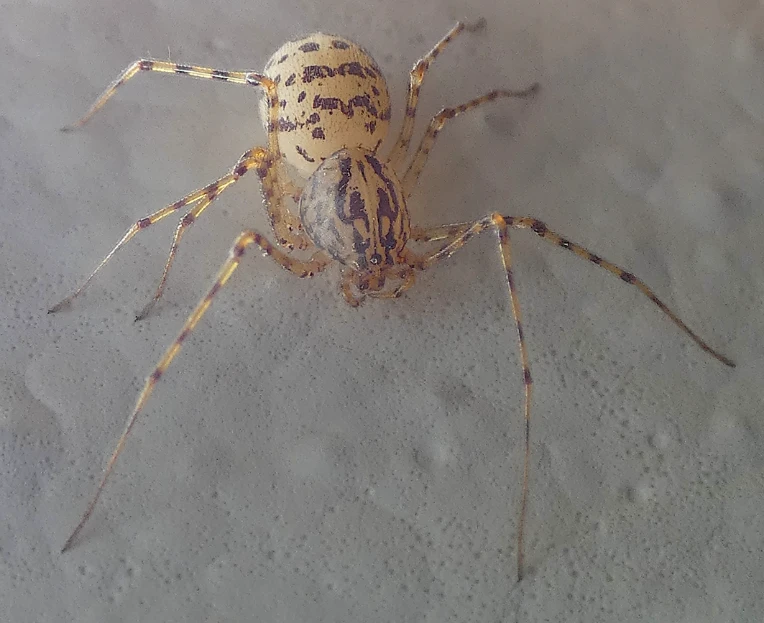
A female spitting spider (Scytodes thoracica) that lives in my house. The name derives from the fact that she spits a venomous sticky silken substance over her prey. The size ranges between 3–6 mm. The carapace is unusual in sloping upwards towards its rear end, whereas the abdomen slopes downwards. Unlike other spiders has only 6 eyes instead the usual eight. You can find this species in Europe, North Africa, Turkey, temperate Asia to China, Korea, Japan. It was introduced in North America, Argentina, India, Australia, and New Zealand.
Hunting starts during the night and the spider sneaks very carefully towards its prey and, from about 10 mm, stops and carefully measures the distance to its prey with one front leg without disturbing it. Then it squeezes the back of its body together and spits two silk threads in a zigzag manner over the victim. The prey is immediately immobilized. This is how an immobilized prey looks:
https://upload.wikimedia.org/wikipedia/commons/f/f1/FliegeSpeispinne.jpg
Fun fact: some species exhibit presocial behaviour, in which mature spiders live together and assist the young with food.
Zoropsis spinimana
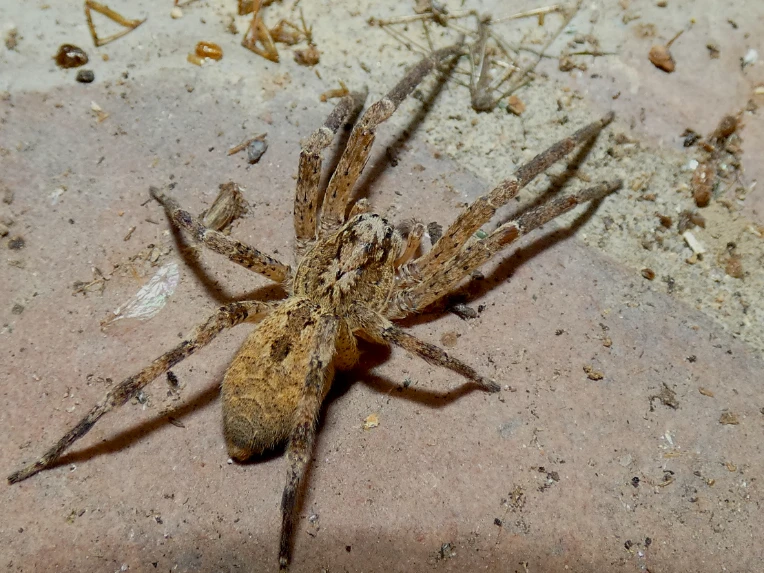
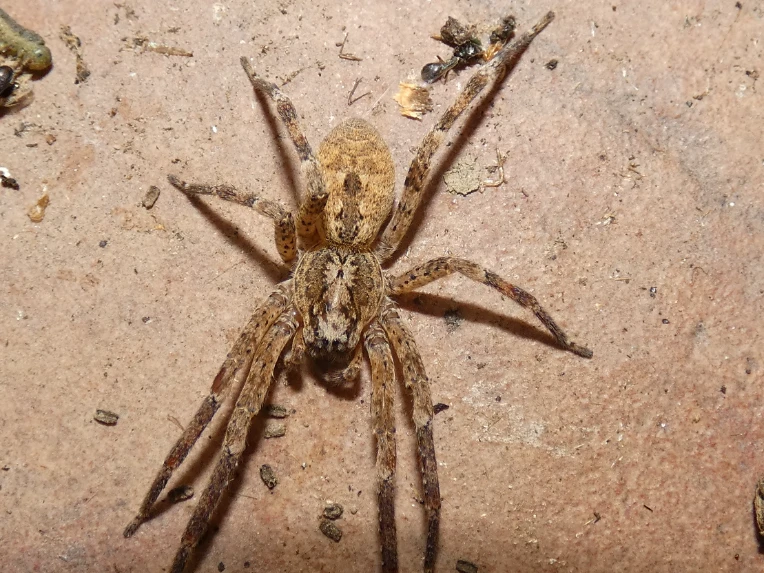
A beautiful female false wolf spider (Zoropsis spinimana) I found in my house while cleaning the yard last year. I gently hold her and put in a safe place as I had to wash that area. Awwww, my heart melts looking at her (I love spiders so much). I took other pics of this beauty. Like in all spiders females are larger than males and this species reaches a length around 15–18 mm while males are 10-12 mm. You can see how the brownish prosoma has broad darker markings, ophistosoma has median black markings. The legs are mainly a speckled brown color.
They primarily hunt freely at night, meaning they do not build a web. Spider are sexually mature in autumn. The females lay eggs in spring, resting in a brood chamber on the cocoon. The species is distributed widely in the Mediterranean, but reaches into Russia, and was introduced to the United States (San Francisco area) in 1990s and to the United Kingdom (London area). It can reproduce north of the Alps because of climate change and now a 2023 find describes the species even in Copenhagen.
The female lays eggs in a silken sac, which she guards diligently until they hatch. The sac is often hidden in crevices or under rocks to protect it from predators. Young spiders, or spiderlings, emerge from the eggs looking like miniature adults. They are independent from birth and start hunting small insects soon after their first molt.
In terms of hunting behaviour, Zoropsis spinimana does not construct webs to catch prey. Instead, it relies on its agility and hunting skills, wandering at night to hunt down its prey.
Like most spiders they are venomous however, their venom is not harmful to humans under normal circumstances. It is primarily used to immobilize their prey. Their diet mainly consists of insects and other small arthropods. Their presence in an area can indicate a healthy insect population, which is vital for ecological balance.
Fun fact 1: in Germany they are called Nosferatu-Spinne because the abdominal black marking evokes the vampire of the 1922 German silent film Nosferatu
Fun fact 2: Zoropsis spinimana spiders have been observed to “play dead” when threatened, a behavior not commonly seen in spiders.
Fun fact 3: despite their roaming nature, these spiders are known to return to the same hiding spot regularly, showing a sense of territoriality or preference for their chosen home base.
Trochosa ruricola and Euborellia moesta
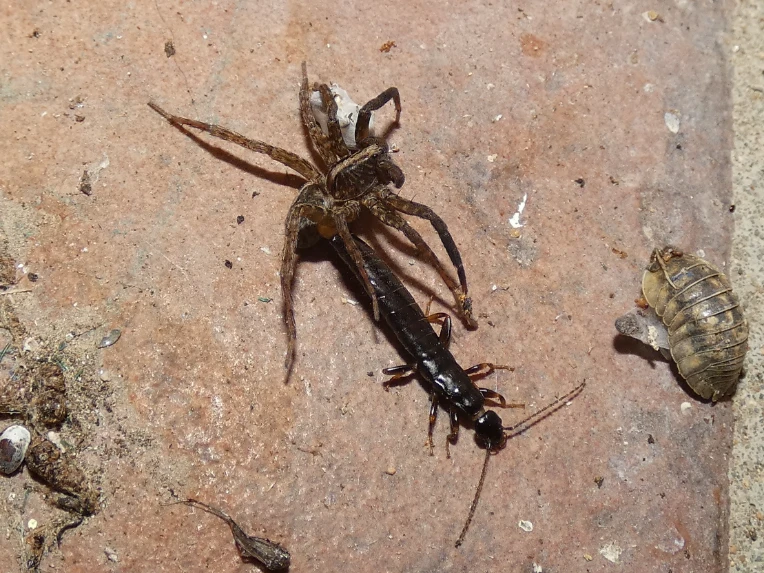
An interesting case of predation from a male rustic wolf spider (Trochosa ruricola) towards a male Southern European earwigs (Euborellia moesta) I could observe before washing my yard (after taking pics I took them and put in my vegetable garden to avoid killing them with water). If you take a closer look under the spider's right third leg you will notice the earwig counterattacked and hit with his forcep-like pincers right in the area between book lung and digestive tubules, causing the wolf spider great damage. The earwig escaped then after the spider gave up hunting him. I know the earwig had to defend himself but at the same time I felt bad for the spider. I hope he recovered after this unpleasant experience.
The females are 15 mm but can reach 25 mm, and the males are 10 mm. Both sexes are dark brown and have a pale band that runs down to the carapace and continues to the abdomen. The spider hunts on the ground and often gets caught in pitfall traps(1). Females carry an egg sac around on their abdomen for around 3 weeks until spiderlings emerge and gather on the mother's back. Grassland, woodland, scrub, and lawns of temperate Asia, Europe, North America, Cuba, Puerto Rico, and Bermuda (in the last five countries it is introduced(2)).
E. moesta is a common earwig (Dermaptera, family Anisolabididae) in the Southern parts of Europe. The female lays several batches of eggs between May and August. The larval development is often completed in September. Although omnivorous, E. moesta is an occasional predator. It lives alone, showing territorial aggression. However, the fights end without any wound to opponents. Mating occurs with aggressive preliminaries, without any courtship behavior. The intra-specific aggressivity appears by the end of the first larval instar(3).
The earwig in this photo is at third larval stage considering the number of antennae segments.
References and footnotes:
(1) Hopkin, Steve. "Trochosa ruricola in Cornwall". Stevehopkin.co.uk.
(2) "Trochosa ruricola". World Spider Catalog.
(3) Blancheteau, Marc & Jean-Pierre, Lumaret. (1979). Observations préliminaires sur la vie et le comportement d’Euborellia moesta (Géné) (Dermaptère) en conditions d’élevage. Vie et Milieu. 28-29. 211-236.